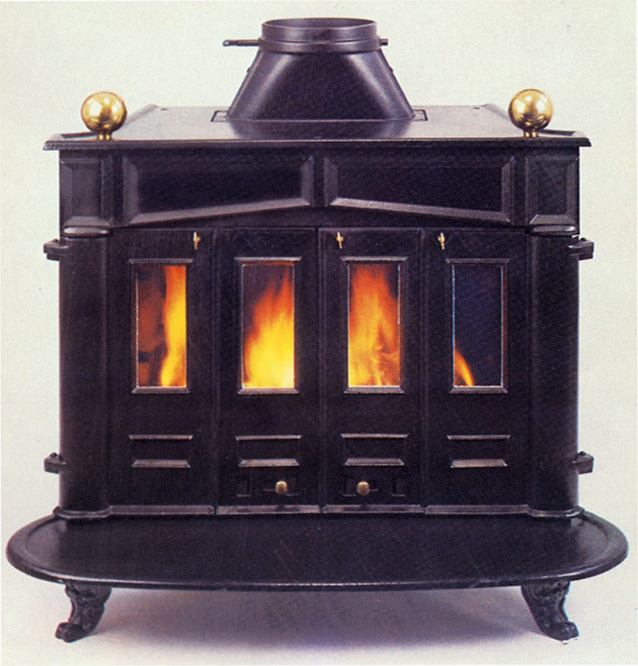The Franklin stove, an innovative creation of Benjamin Franklin, stands as a testament to the ingenuity of early industrial technology. Originating during an era marked by the Little Ice Age, when severe winters plagued colonial America, this pioneering stove was designed to improve heating efficiency while decreasing wood consumption. Franklin’s inventive spirit not only revolutionized domestic heating but also significantly contributed to the history of science, enhancing understanding of atmospheric phenomena like the Gulf Stream. In her insightful review, historian Joyce Chaplin delves into Franklin’s contributions, illuminating the connections between his inventions, climate adaptation, and the broader implications for energy use. With works like Chaplin’s “The Franklin Stove: An Unintended American Revolution,” the legacy of Franklin’s inventions continues to resonate in today’s dialogue about sustainability and technology.
Known colloquially as the Pennsylvania fireplace, the Franklin stove revolutionized home heating much like other inventions of the Enlightenment period influenced daily life. This notable apparatus allowed colonists to generate more warmth for less fuel, thereby ushering in a new understanding of energy efficiency that echoes through modern discussions about resource conservation. The invention not only served practical purposes but also encouraged scientific exploration in fields such as meteorology and environmental science. By studying Franklin’s approaches to heating and air circulation, we gain insights into historical climate adaptation strategies that remain relevant today. Joyce Chaplin’s examination of these developments emphasizes the importance of integrating historical perspectives into our contemporary challenges related to climate change and the sustainable use of technology.
The Ingenious Franklin Stove: A Revolution in Heating
One of Benjamin Franklin’s significant contributions to the world of innovation is the Franklin stove, an invention that not only transformed household heating but also showcased his understanding of convection and thermal dynamics. Developed during the harsh winters of the Little Ice Age, the stove was designed to burn less wood while producing more heat, making it a remarkable climate adaptation for its time. This inventive approach reflects Franklin’s broader scientific explorations and his awareness of the environmental challenges faced by the growing population in colonial America.
The Franklin stove operated on the principle of convective heating, allowing warm air to rise and circulate efficiently within living spaces. This innovative method not only provided greater comfort for families but also highlighted Franklin’s contribution to the history of science and technology. By linking the principles of atmospheric phenomena, like the Gulf Stream, to everyday applications such as home heating, Franklin’s invention encompassed a broader understanding of the interconnectedness of environmental science and domestic life.
Joyce Chaplin’s Insight into Franklin’s Scientific Contributions
In her latest work, Joyce Chaplin delves into the significance of Benjamin Franklin’s inventions, particularly focusing on the Franklin stove and its implications for future generations. Chaplin draws connections between Franklin’s obsession with improving heating methods and the historical context of climate change during his era. As she examines the impact of deforestation and rising fuel costs during the cold winter of 1740-41, she posits that Franklin’s innovative spirit was a direct response to the challenges faced by his contemporaries.
By weaving together narratives of Franklin’s life and the scientific developments of the 18th century, Chaplin provides a fresh perspective on his legacy. She emphasizes that the Franklin stove is not merely a historical artifact but an essential part of understanding how early forms of climate adaptation emerged in response to environmental pressures. Through her examination, it becomes apparent that Franklin’s work was instrumental in laying the groundwork for future discourse on energy efficiency and sustainable technologies.
The Connection Between Invention and Understanding Natural Phenomena
Franklin’s innovations, particularly the Franklin stove, underscore a pivotal point in the history of science where practical invention meets theoretical understanding. Chaplin highlights how Franklin utilized the principles of thermodynamics to explain not just the mechanics of his heating stove but also broader atmospheric phenomena. This dual application of knowledge illustrates how he brought scientific concepts from the laboratory into the living room, making the science of climate accessible to the general public.
Additionally, Franklin’s insights into convection and heat distribution allowed him to draw parallels between domestic heating solutions and larger-scale atmospheric processes. By correlating the behavior of warm air rising in a room to how storm systems develop and move along the Atlantic coast, he effectively demonstrated the importance of interconnectedness in environmental sciences. This legacy of bridging invention and scientific inquiry continues to resonate, emphasizing the need for a holistic understanding of climate systems in today’s discussions on sustainability.
Franklin’s Influence on Modern Climate Adaptation Strategies
The legacy of the Franklin stove extends beyond its immediate practical applications; it serves as a precursor to modern climate adaptation strategies. As Joyce Chaplin discusses in her book, Franklin’s approach to improving heating efficiency reflects an early form of environmental consciousness and a proactive mindset toward technological solutions. By prioritizing efficiency and reducing wood consumption, Franklin addressed both the comfort of individuals and the sustainability of resources during an era of significant climate challenges.
In today’s context, Franklin’s innovative spirit can inspire contemporary responses to climate change. Just as he sought to enhance living conditions during a notably cold period, modern inventors and scientists are now tasked with tackling the complex challenges posed by global warming and environmental degradation. Lessons from Franklin’s era remind us of the importance of leveraging technology not as a singular solution but as part of a comprehensive strategy aimed at mitigating climate impacts through collaboration and diverse solutions.
Understanding Franklin’s Technological Innovations in Historical Context
To fully appreciate the significance of the Franklin stove, it is essential to place it within the broader context of 18th-century technological advancements. Franklin lived in a time when scientific curiosity was beginning to flourish, heavily influenced by figures such as Isaac Newton. His deep-seated interest in natural philosophy drove him to explore various domains, from electricity to meteorology, culminating in inventions that directly addressed the needs of society. The stove, which allowed for better heating in homes, stands as a testament to Franklin’s prowess in both science and practical application.
Joyce Chaplin notes that Franklin’s inventions were often in response to environmental challenges of his day, showcasing an early understanding of climate adaptation. The stove not only provided a solution for heating homes more efficiently but also signified an evolving relationship between humanity and nature. Understanding this connection becomes increasingly important as we face similar climatic challenges today. By examining the historical context of Franklin’s innovations, we can discern the necessity for continuous adaptation and creativity in our responses to current environmental issues.
Educational Impact of the Franklin Stove on Science Communication
Another noteworthy aspect of Franklin’s work is his ability to communicate complex scientific ideas to the general public. Through his writings and pamphlets explaining the functionality of the Franklin stove, he made scientific concepts, like convection, accessible to a broad audience. This dedication to education played a pivotal role in promoting an informed public, who were better equipped to understand and engage with the science of their time. Chaplin emphasizes how Franklin mastered the art of science communication, using relatable analogies and straightforward explanations.
The educational impact of the Franklin stove reflects a critical turning point in how science was perceived in society. Instead of being the realm of a select few, scientific discourse began to permeate everyday life, making it more inclusive. Franklin’s legacy as an educator and communicator inspired future generations to engage with scientific inquiry and innovation, something that remains essential in addressing modern climate challenges. By fostering an informed populace, we can hope to cultivate a society that is proactive rather than reactive to environmental changes.
The Franklin Stove as a Catalyst for Energy Efficiency
Energy efficiency remains a central theme in discussions about climate change, and the Franklin stove is an early example of how innovation can drive improvements in this area. Chaplin highlights that Franklin sought to minimize emissions and enhance fuel efficiency by designing a stove that utilized resources judiciously. This innovative design not only improved heating performance but also highlighted the potential for human ingenuity to address environmental issues through improved technology.
By understanding the mechanics of combustion and air flow, Franklin was able to create an appliance that mitigated waste and improved indoor air quality, a precursor to modern energy-efficient designs. This concept resonates with ongoing efforts to promote sustainability in energy consumption today. The Franklin stove serves as both a historical reference and a source of inspiration for contemporary environmental solutions, emphasizing the continual need for innovation in energy technology.
Examining the Socioeconomic Implications of Franklin’s Innovations
The impact of Franklin’s inventions, including the Franklin stove, extends beyond mere technological advancements; they also carry significant socioeconomic implications. During a time of economic disparity and resource scarcity, Franklin’s stove provided a solution to heating that was accessible to a broader population, addressing concerns about fuel availability. It is essential to recognize that such innovations not only improved individual comfort but also aimed at reducing societal inequalities related to resource access.
Joyce Chaplin’s exploration of Franklin’s life reveals how his inventions were intrinsically linked to the socio-political climate of colonial America. The stove not only served functional purposes but also symbolized a shift towards greater personal agency in adapting to environmental challenges. As modern society confronts similar disparities in access to energy and resources, Franklin’s legacy emphasizes the importance of considering the socioeconomic dimensions of technological innovation in our pursuit of sustainable solutions.
The Legacy of Franklin’s Scientific Inquiry in Modern Times
The enduring legacy of Benjamin Franklin’s scientific inquiry is evident in numerous fields today, particularly in energy efficiency and climate adaptation. His work with the Franklin stove exemplifies how historic inventions can shape modern understandings of environmental science and public health. Franklin’s approach to tackling practical problems with innovative solutions continues to inspire contemporary scientists and inventors in their quest for sustainable technologies.
As we face pressing global challenges, the relevance of Franklin’s methods cannot be overstated. His commitment to observing natural phenomena and striving for technological improvement serves as a foundational blueprint for current efforts aimed at addressing climate change. Chaplin’s examination of Franklin’s achievements reminds us that the intersection of science, invention, and societal needs is vital in navigating the complexities of our modern world, encouraging ongoing exploration and adaptation.
Frequently Asked Questions
What is the Franklin stove and how does it relate to Benjamin Franklin’s inventions?
The Franklin stove, invented by Benjamin Franklin in the 1740s, is a unique heating device designed to improve heating efficiency in homes. Unlike traditional fireplaces, the Franklin stove utilizes a design made of iron plates that allow for better air circulation and heat distribution, making rooms warmer while using less wood. This invention exemplifies Franklin’s innovative spirit and commitment to enhancing comfort through science.
How did Benjamin Franklin’s stove contribute to our understanding of atmospheric phenomena?
Franklin’s stove was instrumental in furthering the understanding of atmospheric phenomena, particularly through its principles of convection. He illustrated how warm air rises and creates a draft, which he compared to storm systems moving along the Atlantic coast and the Gulf Stream. By explaining these processes, Franklin made complex scientific concepts accessible to the public, linking everyday heating to broader environmental systems.
What historical context influenced the development of the Franklin stove?
The development of the Franklin stove was greatly influenced by the harsh winter of 1740-1741, during which major harbors froze over, causing widespread suffering and famine. Recognizing the need for better heating solutions as settlers deforested the land, Franklin’s invention was a climate adaptation aimed at improving warmth and comfort during cold months.
In what ways did Joyce Chaplin’s research on the Franklin stove highlight Franklin’s approach to climate adaptation?
Joyce Chaplin’s research reveals that Franklin’s design of the stove was not only about creating warmth but also about addressing the environmental concerns of his time, such as fuel scarcity and air quality. By re-burning smoke and optimizing fuel usage, Franklin aimed to minimize emissions and improve indoor air quality, demonstrating early awareness of the relationship between technology and environmental impact.
Why might the Franklin stove be considered one of Benjamin Franklin’s lesser-known inventions?
The Franklin stove is often overshadowed by more famous inventions like the lightning rod or bifocals. However, due to its significant environmental implications and connection to Franklin’s broader scientific work, scholarly attention, particularly from historians like Joyce Chaplin, is beginning to recognize its importance as an innovative solution to heating challenges.
What impact did the Franklin stove have on energy consumption and efficiency in the 18th century?
The Franklin stove had a significant impact on energy consumption by enabling households to heat their spaces more efficiently, reducing the amount of wood required for heating. This efficiency appealed to many colonists who faced rising firewood costs and scarcity, as it helped conserve resources while improving indoor comfort significantly.
How does Joyce Chaplin’s book connect the legacy of the Franklin stove to current climate challenges?
In her book, Joyce Chaplin connects the legacy of the Franklin stove to today’s climate challenges by emphasizing the need for innovative solutions to complex environmental issues. She warns against relying on single inventions to solve climate crises, advocating for a multifaceted approach involving various technologies and adaptive strategies to mitigate climate change effectively.
| Key Aspects of the Franklin Stove | Significance | Historical Context | Environmental Impact | ||
|---|---|---|---|---|---|
| Improved heating efficiency | Created during the severe winter of 1740-41 | Helped to reduce wood consumption by burning less fuel | |||
| Designed to be constructed from flat iron plates | Prototyped as a climate adaptation measure | Promoted understanding of atmospheric phenomena such as the Gulf Stream | |||
| Catalyzed new scientific thinking | Introduced to combat the challenges of a growing population and deforestation | Minimized smoke emissions through innovative design | |||
| Influenced modern heating technology | Promoted a shift from wood to coal | Encouraged scientific accessibility for the public | |||
| Created the groundwork for further innovations | Demonstrated Franklin’s ingenuity beyond popular inventions | Reflected early concerns about air quality and emissions | |||
Summary
The Franklin stove stands as a testament to Benjamin Franklin’s innovative spirit and scientific acumen, representing a pivotal moment in the interplay between technology and environmental awareness. Designed during one of the harshest winters in history, this invention not only offered a practical solution for heating but also sparked a new understanding of atmospheric sciences. By addressing the pressing energy needs of early American society amidst deforestation, the Franklin stove laid the groundwork for future technological advancements, highlighting the importance of optimizing energy efficiency while being mindful of emissions. As we reflect on the historical significance of the Franklin stove, we can see parallels in today’s climate discussions, urging us to seek sophisticated, multi-faceted solutions to contemporary energy challenges.



